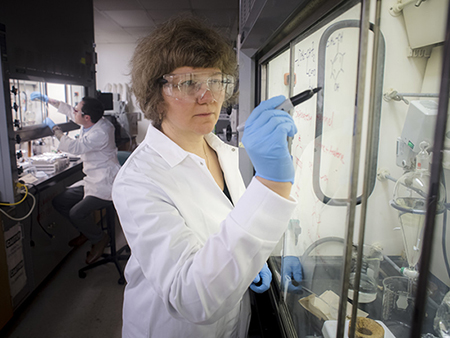Layers of tannic acid and another biopolymer delay allograft and autoimmune-mediated rejection in mouse models of Type 1 diabetes.
 Photography: Steve WoodType 1 diabetes, or T1D, results from the autoimmune destruction of the insulin-producing cells of the pancreas. People with T1D require exogenous insulin and suffer swings in the levels of glucose in the blood that impact life expectancy and increase risks of cardiovascular disease, neuropathies and kidney failure.
Photography: Steve WoodType 1 diabetes, or T1D, results from the autoimmune destruction of the insulin-producing cells of the pancreas. People with T1D require exogenous insulin and suffer swings in the levels of glucose in the blood that impact life expectancy and increase risks of cardiovascular disease, neuropathies and kidney failure.
One therapy is promising — transplanting pancreatic islets from cadavers. But this requires immunosuppression, and reactivated autoimmunity leads to low graft viability and function after five years.
Now, a team of University of Alabama at Birmingham researchers has shown a simple way to protect transplanted islets, by coating them with a thin skin of alternating layers of two biopolymers. As reported in the journal Diabetes, this coating delays allograft and autoimmune-mediated rejection in mouse models of T1D.
“Our approach to inhibit proinflammatory immune responses with poly(N-vinylpyrrolidone)-tannic acid-encapsulated islets without systemic immunosuppression is a significant advancement toward successful islet transplants in humans,” said senior authors Hubert Tse, Ph.D., and Eugenia Kharlampieva, Ph.D.
The biocompatible poly(N-vinylpyrrolidone)-tannic acid, or PVPON and tannic acid, or TA, are coated onto the islets in multiple alternating layers that are thin enough to allow oxygen and nutrients to easily reach the cells. This nano-thin encapsulation is about 120 times thinner than a sheet of plastic cling wrap. The key to its autoimmune protection, the UAB researchers say, are the layers of TA. This phenolic compound can scavenge reactive oxygen species and has an anti-inflammatory effect.
Oxidative stress from reactive oxygen species, or ROS, was already known to play a key role in the activation of alloreactive and autoreactive immunity toward engrafted islets, and the insulin-producing beta cells of the islets are more sensitive to ROS than many other cells of the body.
In autoimmune transplant experiments for the UAB study, more than half of the (PVPON/TA)-encapsulated grafts survived at 70 days post-transplant, while less than a quarter of the non-encapsulated grafts survived. In alloimmune transplant experiments, where the islets came from a different strain of mice, about 40 percent of the encapsulated grafts survived at 120 days post-transplant, while all of the unencapsulated grafts were rejected in less than 50 days.
In both types of transplantation, systemic immunosuppression was absent. The (PVPON/TA)-encapsulated islets maintained euglycemia significantly longer than non-encapsulated islets, and the grafts were immunomodulatory.
The mice receiving the encapsulated grafts had significant decreases in immune cell infiltration, ROS synthesis, inflammatory chemokines, cytokines and CD8 T cell infiltration, as compared to mice getting the non-encapsulated islets. ROS is known to promote proinflammatory M1 macrophages differentiation; in contrast, the mice receiving the encapsulated islets showed an increase in anti-inflammatory M2 macrophages.
 Hubert Tse, Ph.D.Tse and Kharlampieva say much more can be done to improve immunosuppression by the encapsulation and extend that protection to other sources of islets that are more readily available than human cadaver islets.
Hubert Tse, Ph.D.Tse and Kharlampieva say much more can be done to improve immunosuppression by the encapsulation and extend that protection to other sources of islets that are more readily available than human cadaver islets.
“PVPON/TA coatings can be modified to increase the number of layers of PVPON and TA for encapsulation, complexed with immune inhibitory receptors, including CTLA-4, PD-L1, and/or anti-inflammatory cytokines like IL-10 and TGF-beta, to further enhance localized immunosuppression,” they said. “The use of PVPON/TA coatings is not limited to encapsulation of human islets, as our preliminary studies also demonstrate that PVPON/TA encapsulation does not compromise neonatal porcine islet function and can also be expanded to include human stem cell-derived pancreatic beta-cells.”
At UAB, Tse is an associate professor in the UAB Department of Microbiology, and Kharlampieva is a professor of chemistry in the UAB College of Arts and Sciences.
Co-authors with Tse and Kharlampieva for the Diabetes study, “Localized immunosuppression with tannic acid encapsulation delays islet allograft and autoimmune-mediated rejection,” are Jessie M. Barra, UAB Department of Microbiology, and Veronika Kozlovskaya, Ph.D., UAB Department of Chemistry.
Support came from National Institutes of Health grants DK099550, T32.GM109780 and T32.GM008111; JDRF awards SRA-2016-270-S-B and 2-SRA-2019-692-S-B; and National Science Foundation grant NSF-DMR 1608728.
"type" - Google News
October 23, 2020 at 12:01AM
https://ift.tt/35sXrOV
Type 1 diabetes: Tannic acid encapsulation protects transplanted islets from rejection - The Mix
"type" - Google News
https://ift.tt/2WhN8Zg
https://ift.tt/2YrjQdq
Bagikan Berita Ini














0 Response to "Type 1 diabetes: Tannic acid encapsulation protects transplanted islets from rejection - The Mix"
Post a Comment